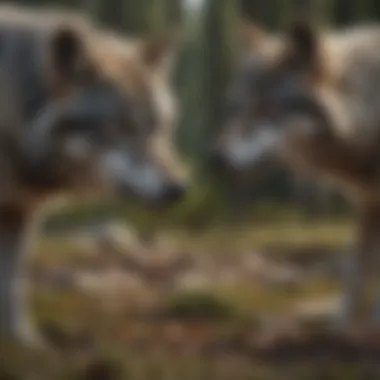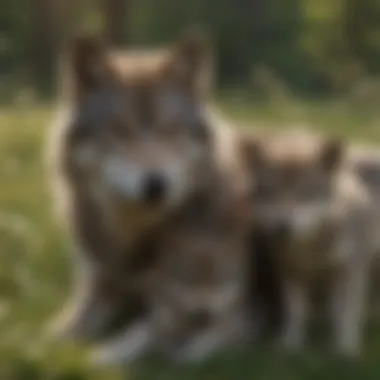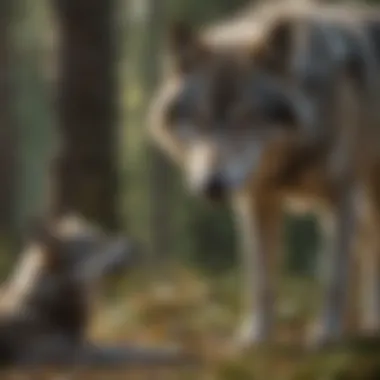Unveiling the Enigmatic Grey Wolves of North America: A Comprehensive Exploration


Nature Topic Overview
Grey wolves, also known as timber wolves, are fascinating creatures that roam the vast wilderness of North America. These majestic predators play a crucial role in maintaining the delicate balance of the ecosystem. From their intricate social structure to their hunting techniques, there is much to uncover about these enigmatic animals.
Fun Facts and Trivia
- Grey wolves communicate through howling, with each pack having its unique howl pattern.
- They can run at speeds of up to 35 miles per hour when chasing prey.
- A wolf's sense of smell is so powerful it can detect scents from over a mile away.
- Wolves have strong family bonds within their packs, working together to care for their young.
Wildlife Explorations
In addition to grey wolves, North America is home to a diverse range of wildlife species. From the agile deer to the elusive mountain lion, each animal plays a vital role in the ecosystem. Explore the dynamic relationship between predators and prey, and delve into the unique adaptations that enable these creatures to thrive in their habitats.
Environmental Awareness
Conservation efforts are instrumental in safeguarding the habitats of grey wolves and other endangered species. Children can contribute to wildlife protection by learning about sustainable practices and supporting conservation initiatives in their communities. By raising awareness and taking action, we can work towards preserving the rich biodiversity of North America for future generations.
DIY Nature Activities
Engage young minds with hands-on activities inspired by the natural world. Encourage children to create wildlife-themed crafts, such as wolf masks or animal track drawings. Foster a sense of curiosity through outdoor explorations like bird watching and plant identification. By immersing themselves in nature, children can develop a deeper appreciation for the environment and the creatures that call it home.
Introduction
Grey wolves have long captivated the human imagination, eliciting both awe and fear with their cunning hunting strategies and complex social structures. The introduction sets the stage for a deep dive into the enigmatic world of these elusive canines, shedding light on their significance not just as predators but as key players in maintaining ecological balance. From their early interactions with Native American cultures to their contentious coexistence with modern society, every aspect of the grey wolf's existence shall be meticulously scrutinized to provide a holistic understanding of their place in North America's natural landscape.
As we unravel the nuances of grey wolf biology and behavior, a nuanced portrayal emerges, challenging preconceived notions and stereotypes attributed to these apex predators. Through a lens sharpened by scientific inquiry and enriched by indigenous wisdom, this article strives to present a nuanced narrative that champions conservation while respecting the intrinsic value of these magnificent creatures. Join us on this illuminating journey as we decode the mysteries of the grey wolf, illuminating the pages with tales of resilience, adaptability, and the enduring spirit of the wild.


Historical Background
In delving into the complexities of grey wolves in North America, understanding their historical background becomes paramount. The historical context provides crucial insights into the evolution of these remarkable predators, shedding light on their interactions within the ecosystem and with human civilizations over centuries. Exploring the historical background offers a lens through which we can appreciate the resilience and adaptability of grey wolves, shaping our comprehension of their current status and conservation needs.
Early Presence of Grey Wolves
The early presence of grey wolves holds a pivotal role in shaping their narrative in North America. Dating back to prehistoric times, grey wolves roamed vast territories, establishing themselves as apex predators with a significant impact on their environments. Understanding their initial distribution and behavioral patterns provides valuable perspectives on the natural history of these elusive creatures, unraveling the dynamic dynamics that governed their interactions with other species and habitats.
Role in Native American Culture
The grey wolf's role in Native American culture is deeply rooted in reverence and symbiosis. Across various indigenous tribes, wolves symbolize strength, loyalty, and intuition, often portrayed in folklore and spiritual practices as guardians and teachers. Exploring the cultural significance of wolves unveils a profound connection between humans and nature, highlighting the profound respect and understanding that ancient societies held for these majestic animals. Delving into their symbolic representation elucidates the intricate tapestry of beliefs and values that endure to this day, impacting conservation efforts and coexistence strategies.
Physical Characteristics
In the realm of understanding North American Grey Wolves, exploring their Physical Characteristics is paramount. These attributes play a vital role in defining the essence and visual identity of these iconic predators, offering insights into their adaptations and survival strategies. Size and Weight as well as Coat Color and Markings serve as distinctive features that set Grey Wolves apart from other species, showcasing the intricate mechanisms of nature at work.
Size and Weight
Delving into the Size and Weight of Grey Wolves offers a profound glimpse into their physical stature and evolutionary traits. Grey Wolves are renowned for their robust build and agile physique, with males typically exhibiting larger dimensions compared to females. The average weight of a Grey Wolf ranges between 60 to 120 pounds, showcasing a remarkable balance of strength and agility crucial for hunting and territorial behaviors. Understanding the correlation between Size and Weight provides valuable insights into the dynamics of dominance within wolf packs and their strategic advantages in hunting and survival.
Coat Color and Markings
The Coat Color and Markings of North American Grey Wolves unveil a captivating story of adaptation and camouflage in the wild. Their distinctive fur patterns, ranging from shades of gray to white, offer protective concealment in various habitats, aiding in hunting efficiency and social signaling. The interplay of genetics and environmental factors shapes the Coat Color and Markings of Grey Wolves, reflecting their resilience in diverse terrains and climates. Exploring the nuances of Coat Color and Markings sheds light on the evolutionary significance of visual cues in communication, camouflage, and mate selection among Grey Wolves.
Habitat and Range


Grey wolves in North America inhabit diverse habitats that play a crucial role in their survival and ecological impact. Understanding their habitat and range is essential to grasping the complexity of their existence. The varying landscapes where grey wolves reside, from dense forests to open plains, provide different advantages and challenges for these predators. Their habitat influences their hunting strategies, social dynamics, and overall behavior. The range of grey wolves extends across vast territories, showcasing their adaptability to different environments and climates. Studying their habitat and range not only sheds light on the wolves' lifestyle but also offers valuable insights into ecosystem dynamics and conservation needs.
Preferred Habitats
Grey wolves exhibit a preference for habitats with abundant prey populations, such as deer and elk, essential for their sustenance. Forested areas are often favored by wolves due to the cover they provide for hunting and denning. These habitats offer a balance of resources and shelter, enabling wolves to thrive and maintain healthy population numbers. Understanding the preferred habitats of grey wolves helps conservationists in designing effective protection measures and habitat restoration initiatives to ensure the species' long-term survival and well-being.
Distribution Across North America
The distribution of grey wolves across North America is diverse, reflecting the historical and current relationships between wolves and human activities. Wolves can be found in regions such as the Northern Rocky Mountains, the Great Lakes, Alaska, and parts of the Pacific Northwest. However, the distribution of grey wolves has been heavily impacted by human encroachment, leading to historical declines in population numbers. Efforts to conserve and restore wolf populations in various regions aim to promote a more balanced and sustainable coexistence between humans and this iconic predator.
Behavior and Social Structure
Hunting Patterns
Delving into the hunting patterns of Grey Wolves reveals a sophisticated strategy honed through generations. These skillful predators exhibit a remarkable blend of teamwork, patience, and precision during hunts. From strategic coordination during group hunts to solitary pursuits, their hunting techniques are a tapestry of coordinated efforts and individual prowess. Understanding their hunting patterns sheds light on the adaptability and intelligence integral to their survival in diverse landscapes and prey-rich environments.
Pack Dynamics
The Pack Dynamics of Grey Wolves offer a fascinating glimpse into their societal structure and behavioral intricacies. Within a pack, each member plays a defined role based on factors like age, experience, and hierarchy. The alpha pair holds a significant position, guiding the pack's decisions and maintaining order. Subordinate wolves contribute to the pack's cohesion through roles such as hunting, caring for pups, and territorial defense. Studying Pack Dynamics unravels the complex interplay of dominance, cooperation, and kinship that form the foundation of grey wolf communities.
Ecological Importance
The ecological importance of grey wolves in North America cannot be overstated. These majestic creatures play a crucial role in maintaining the balance of the ecosystem. Their presence influences the population dynamics of various species, acting as a keystone species. By preying on herbivores, wolves help control their numbers, preventing overgrazing in certain areas. This, in turn, allows vegetation to thrive and creates a ripple effect across the entire ecosystem. Additionally, as apex predators, wolves regulate the distribution of species lower in the food chain, contributing to overall ecosystem stability and biodiversity. Their influence extends even further by influencing the behavior of prey animals, ultimately shaping the landscape and its inhabitants.
Role in the Ecosystem


The role of grey wolves in the ecosystem is multifaceted and far-reaching. As apex predators, they hold a position of power that reverberates throughout the food web. Wolves act as regulators, controlling the populations of herbivores such as deer and elk. This control prevents overgrazing, which can have detrimental effects on plant communities. By managing prey populations, wolves indirectly impact the health of various plant species and their associated wildlife. Furthermore, their presence triggers a cascade of effects down the food chain, influencing the behavior and distribution of a wide array of species. In this way, grey wolves shape the ecosystem in a complex but essential manner.
Impact on Prey Populations
The impact of grey wolves on prey populations is a critical aspect of their ecological role. Through predation, wolves help maintain a healthy balance among herbivore species. By selectively targeting individuals within a population, they prevent overpopulation and its subsequent consequences. This selective pressure exerts by wolves promotes genetic diversity within prey species, enhancing their overall resilience to environmental changes. Moreover, by keeping herbivore numbers in check, wolves indirectly protect plant communities from overconsumption, ensuring the sustainability of vegetation across their habitat. Thus, the impact of grey wolves on prey populations extends far beyond individual interactions, contributing significantly to the health and equilibrium of the ecosystem.
Conservation Status
Historical Decline
The Historical Decline of grey wolves is a poignant chapter in their narrative. Over centuries, human activities such as habitat destruction, hunting, and fear-driven extermination campaigns led to a drastic reduction in grey wolf populations. Exploring the Historical Decline unveils the detrimental impact of human interference on these apex predators' existence. Tracing back the decline over time provides valuable insights into the historical mistreatment faced by grey wolves, underlining the importance of concerted conservation efforts to reverse the damage and ensure their survival.
Current Conservation Efforts
Present-day conservation endeavors play a pivotal role in safeguarding the remaining grey wolf populations across North America. By focusing on Current Conservation Efforts, this section highlights the collaborative initiatives aimed at reintroducing wolves into natural habitats, implementing protective legislations, and raising awareness about the significance of coexisting with these carnivores. Understanding the ongoing Conservation Efforts emphasizes the tireless work of wildlife conservation organizations and policymakers in mitigating human-wolf conflicts and establishing sustainable conservation practices. Witnessing the proactive measures undertaken today offers hope for the future conservation and thriving existence of grey wolves in their native lands.
Human-Wolf Conflicts
Human-Wolf conflicts stand as a pivotal issue within the intricate tapestry of interactions between humans and grey wolves. These conflicts arise primarily from the shared landscapes where both species dwell, leading to clashes in territories and resources. The significance of exploring this topic lies in understanding the implications of these conflicts on the survival of both humans and wolves. As apex predators, grey wolves play a crucial role in maintaining ecosystem balance, but their proximity to human habitats can trigger conflicts, posing challenges for conservation efforts and coexistence strategies.
The dynamics of Human-Wolf conflicts encompass a myriad of considerations, ranging from livestock depredation to human safety concerns. Instances of grey wolves preying on livestock have sparked tensions among ranchers and conservationists, prompting debates on sustainable mitigation measures. Understanding the behavior patterns of grey wolves that lead to such conflicts is essential for devising effective strategies that safeguard both livestock and wolf populations. Moreover, addressing human safety risks associated with wolf presence requires a nuanced approach that balances conservation objectives with human well-being.
Furthermore, delving into the socio-economic impacts of Human-Wolf conflicts sheds light on the intricate relationships between communities, ecosystems, and wildlife. These conflicts can have far-reaching consequences on rural economies dependent on agriculture and livestock, highlighting the need for conflict resolution mechanisms that promote coexistence and mitigate negative repercussions. By embracing a holistic perspective that considers ecological, social, and economic dimensions, stakeholders can collaboratively address Human-Wolf conflicts and foster sustainable solutions for shared landscapes.
Conclusion
Grey wolves in North America are not just charismatic predators but also keystone species that play a crucial role in the ecosystem. Their presence influences the balance of various wildlife populations, contributing to biodiversity and overall ecological health. It is imperative to understand the significance of conserving grey wolves to maintain ecosystem stability.
By delving into the world of grey wolves in North America, this article sheds light on the intricate dynamics of these apex predators. From their historical presence to the current conservation efforts being made, readers can grasp the comprehensive importance of safeguarding the grey wolf population.
The behavior, habitat preferences, and social structures of grey wolves serve as critical indicators of ecosystem health. Their hunting patterns and interactions within their packs offer valuable insights into predator-prey relationships and the intricate web of life in North America. Studying grey wolves provides not only a window into the natural world but also a deeper understanding of ecological resilience.
Furthermore, the conservation status of grey wolves underscores the need for continuous efforts to protect and sustain their populations. Historical declines in numbers have highlighted the vulnerable position of these apex predators in the face of human-wolf conflicts and habitat loss. Current conservation initiatives, aimed at restoring populations and mitigating conflicts, are crucial for the long-term survival of grey wolves in North America.







